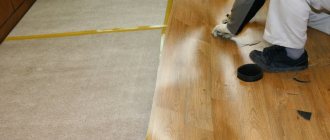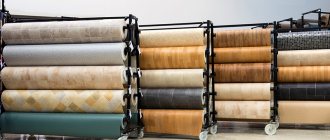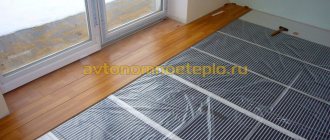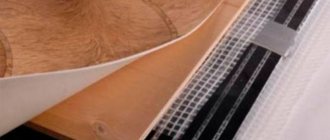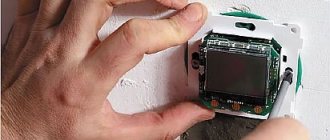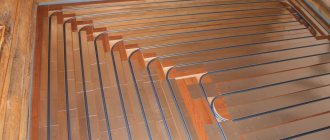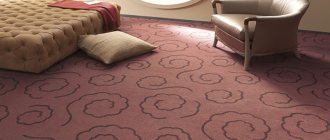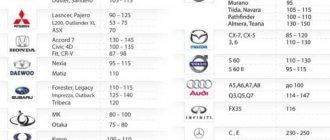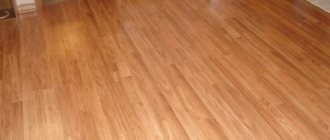In the modern world, a “warm floor” heating system is no longer considered a luxury - it is a cost-effective and convenient way to heat a home. However, not every flooring can be laid on a heating surface. Therefore, when installing such heating systems, many people have a question: is it possible to lay linoleum on a warm floor?
Public opinion has formed in such a way that linoleum does not often act as a finishing coating when installing heated floors. It is believed that when heated, this material can release substances harmful to human health. In addition, it has a soft structure, and under the influence of temperature changes it will quickly become unusable.
There is such a possibility, but only if the linoleum is of poor quality and the temperature conditions during operation of the heating system are not observed.
With the right approach to selection - high quality and a combination of material with heating devices, it will serve no worse than ceramic tiles.
Warm floors and linoleum - search for the optimal design
A typical heated floor draws energy either from the main heating system wiring or from the household electrical network.
That is, in apartments or houses you can install only two options for heated floors: water or electric. Linoleum on the floor
But the possible installation of a heated floor under linoleum suggests that this giant “radiator” will heat up to only 27 degrees Celsius. Since it is at this boundary that the upper limit for the operating temperature of linoleum is set. And if the floor warms up above the specified level, then in addition to controversial sensations from the point of view of comfort, the user will also receive a dose of clearly harmful volatile components that accumulate in this finishing material during the manufacturing process.
In addition, “overheated” linoleum will dry out very quickly and lose its elasticity and strength. As a result, a coating designed to last for years or even decades of operation will lose its “marketable appearance” in a matter of months.
Therefore, the installation of a heated floor under linoleum actually has no restrictions on the type of construction: after all, this type of coating is not afraid of either moisture or electricity (linoleum is a good dielectric with high hydrophobicity). However, both electric and water floors cannot be “warmed up” to 27 degrees Celsius. And the recommended upper temperature limit, in this case, is at 24-26 °C.
And if a water or electric “warm floor” heating system can fall within this range, then it can already be considered ideal. And further in the text we will consider both options for the construction of “warm floors”: both electric and water.
Heating system testing
To do this, set the heating indicator on the thermostat at 20 - 25 degrees and wait a few minutes. Check with your hand whether the mounted film heaters have warmed up. Then the power is turned off completely to see how the electrical connections heat up.
We recommend: Rinnai double-circuit gas boilers: instructions and technical specifications
Their temperature should be the same as that of the film. In the case when it is much higher, this means that the contacts are unreliable. They must be checked, and the cause of excessive heating must be identified and eliminated.
Important features of the thermal regime
In principle, in order to choose linoleum for a warm floor, you do not need to have special knowledge and understand the properties of the material. Coating manufacturers themselves will tell you whether their products can be used for a heated floor system or not. How? Through marking. The permissible heating temperature is also indicated next to the marking - it must be observed. For marmoleum, the limiting temperature is about 27°C; above this limit, its surface begins to soften, melt, and tear. Vinyl linoleum can heat up to 29-30°C, after which it may swell, deform or lose color. Also, phenols and all sorts of unpleasant gases will almost certainly be asked to come out. To maintain the required temperature of the heated floor, you will have to purchase a high-quality thermostat. which will automatically maintain the specified mode.
Linoleum marking allowing the use of coating for underfloor heating systems
How to choose the right one
When choosing linoleum for a “warm floor” system, it is necessary to consider all operational characteristics, technical installation features, and the obvious pros and cons of the material. You can take the easier route and carefully study the manufacturer's recommendations for long-term use of the product.
All important information is encoded in the linoleum markings. There are Russian and European systems. The domestic manufacturer uses digital codes (from minimum traffic to production areas) and letter designations (for example, for PVC linoleum). It is worth paying attention to special icons that indicate the compatibility of linoleum with “warm floors”.
The European UPEC system determines abrasion resistance (from 0 to 4), permanent deformation (from 0 to 4), water resistance, and resistance to chemicals.
The optimal class of linoleum for domestic premises with “warm floors” is 31-43.
For “warm floors” it is worth using linoleum of classes 31-43 with special markings
Particular attention should be paid to the recommended temperature regime. A coating made of natural material will begin to deteriorate at temperatures above 27 degrees Celsius. PVC coating can function at 30 degrees. Exceeding this threshold will lead to a change in the structure, color of the material and the release of toxic substances.
For safe operation of the “warm floor” under the linoleum, it is necessary to install a high-quality temperature sensor. Safe heating modes will allow you to use the floor covering for a long time, without danger to health or the risk of surface deformation.
The optimal thickness of linoleum for “warm floors” is in the range of 2-3 mm. Thinner products wear out quickly and lose strength.
The optimal thickness of the base ensures the necessary thermal conductivity.
When installing an electric floor, it is better to choose linoleum with antistatic properties.
It’s good if you purchase linoleum with antistatic properties - it will “work” better
As mentioned above, the material that is suitable for combination with a “warm floor” has a special marking. Despite the lack of a uniform template, the logo is quite easy to read. If necessary, you can seek the help of a store consultant.
Certified products are a guarantee of material quality. When purchasing flooring, you should pay attention to the presence of a certificate.
Markings on linoleum indicating the possibility of use with “warm floors”
Expert advice on installing heated floors
A few tips from experts will help extend the life of linoleum laid on a floor with a heating system.
Compatibility of tiles and linoleum with heated floor systems
When choosing the type of heated floor, the decisive factor may be the financial issue. A water floor, although considered the most suitable for linoleum, requires significant installation costs and a high professional level of installation specialists. An electric floor is easier to install, but power calculations confirm that it is quite energy-consuming to operate.
Infrared does not require a mandatory screed, but may not withstand external pressure due to its thin design. When installing it, you will need to lay a hard layer between the coating and the heating films. For it you will have to buy a more expensive commercial or semi-commercial option or marmoleum.
For all types of heated floors, the quality of the electric thermostat is important. Overheating the coating will cause blistering and cracking. Installing a heated floor is a complex procedure; if you have no experience in such work, it is better to contact specialists.
Related video: Installation of Caleo underfloor heating under laminate and linoleum
Selection of questions
- Mikhail, Lipetsk — What discs should I use for cutting metal?
- Ivan, Moscow - What is the GOST for rolled sheet steel?
- Maxim, Tver - Which racks for storing rolled metal products are better?
- Vladimir, Novosibirsk — What does ultrasonic processing of metals without the use of abrasives mean?
- Valery, Moscow - How to forge a knife from a bearing with your own hands?
- Stanislav, Voronezh — What equipment is used for the production of galvanized steel air ducts?
Warm electric floor
Electric underfloor heating under linoleum on a wooden floor is considered the most optimal solution of all existing ones. In order to install a warm infrared floor, you should also prepare the base, as described in detail above.
After preparing the base, you need to prepare the tool and purchase the necessary consumables, namely:
- Knife and scissors;
- Crimping cleats for contacts;
- Screwdriver Set;
- Marker, ruler and multi-meter;
- Insulation with foil coating;
- Thermal insulating tape;
- Polyethylene film;
- Infrared film;
Initially, we select the installation location of the thermostat and thermostat.
Next, a separate supply line is laid to the selected installation locations.
The thermal sensor is mounted directly under the film at a distance of at least half a meter from the wall, and the regulator is installed on the wall in a place convenient for you.
Then the infrared film is laid and connected to the power supply. After completing the installation, you need to check the network resistance using a multimeter. After taking measurements and making sure that the resulting system is in full working order, you can carry out a test run. After successful startup and verification of the system’s functionality, it is permissible to begin laying the finishing coating.
Electric heating film
Preparatory work
Preparatory work consists of several independent stages:
- preparing the base for laying the floor;
- installation of a thermostat;
- calculation of system power with subsequent development of a laying scheme;
- floor insulation.
Preparing the base
The film into which the carbon strips are sealed is thin. Any unevenness on the base of the floor can damage it. Therefore, special attention is paid to the preparation of the concrete floor or wooden subfloor. Work is carried out in the following sequence:
- the ceiling is freed from all unnecessary things: remnants of building materials, garbage;
- the old screed is knocked down with a hammer drill;
- The stove is being repaired. Particular attention is paid to cracks (microcracks) and joints. They must be sealed with repair mortar.
Final stages:
- apply 2 layers of primer;
- the surface is leveled with a small screed using a self-leveling floor or covered with plywood (OSB).
The rough wooden floor is also repaired: rotten boards are replaced, creaks are eliminated, and cracks are sealed. How to properly carry out the preparatory work and fill the screed with self-leveling mixtures can be found here.
Installing a thermostat
Installation of infrared heated floors under linoleum begins already at the preparatory work stage: electricity is connected and a thermostat is installed. To do this, the location of the device is first determined. There are two rules here:
- the power regulator should be as close as possible to the heating zone;
- the distance from the floor is at least 30 cm and no more than 1.5 m. It all depends on the presence of small children and pets - the thermostat should be out of their reach. There are no recommendations in this regard in SNiP. Most manufacturers indicate a height of 90 cm. Experience shows that in the absence of external factors, it is best to install at a height of 30 cm.
The place for the thermostat is drilled with a crown
The installation socket for the thermostat is cut out using a hammer drill (electric drill) with a crown.
A seat for the thermostat is cut out.
The supply wires can be routed along the wall and covered with a plastic box. It is more aesthetically pleasing to hide the electrical wiring in the wall. To do this, use a grinder or wall chaser to cut two parallel lines at a distance of 20 mm and to a depth of 2 cm. Using a hammer drill or chisel with a hammer, a channel is knocked out. Wires are laid in the prepared channel. The wall is being plastered.
The channel is cut with a wall chaser.
The groove is cut with a grinder.
The groove is deepened with a hammer drill.
The same operation is carried out to apply voltage to the IR film. A 20x20 mm groove is punched down from the thermostat.
The channel for the wiring is knocked out.
Power calculation
The power value of a film “warm floor” is calculated differently than for cable heating. Here the main parameters are:
- ratio of film area to total area of the room;
- type of heating: main or additional.
The film is not installed under furniture. First of all, why heat her bottom? Secondly, due to overheating, the sofa, wardrobe, table begin to deform. Thirdly, the film itself suffers - heat is transferred down into the floor pie, as a result of which the plastic melts and the carbon strips burn out. Therefore, a diagram of the room is drawn up with the furniture arranged, respecting the scale, which is important.
After this, the length and width of each strip of film are calculated. Here the requirements are:
- the IR heater is placed at a distance of 250-300 mm from the wall;
- There should be 50 mm between stripes.
When drawing a diagram, you need to take into account some requirements and follow the installation rules:
Installation plan for infrared heated floors.
- When calculating the length of the strip, you need to take into account how much film can be cut: 200 or 250 mm. Therefore, it is difficult to meet the requirements for distance from the wall. In this case, the distance is increased;
- the temperature sensor is located inside the strip, but with the condition that the standard wiring is sufficient to reach the temperature sensor. No twists. They distort the signal;
- heating elements should be placed along the room - fewer connection points.
Upon completion of work on drawing up a plan for laying out the film and connecting it to the thermostat, the total area and area of the film are calculated. Based on the calculations, the power of the IR film is determined. There are two approaches here. Some experts recommend taking into account the type of heating: main or auxiliary. Others prefer to install a maximum capacity system. This approach does not affect energy consumption. Consumption is approximately the same. The difference is felt only when purchasing a set - the more powerful one costs more.
Table 1 shows the calculation of power for different rooms for constant heating. For additional heating, the final results should be reduced by 30-35%. Besides. It is necessary to take into account that as the film area increases, the power decreases and vice versa. The ratio is approximately this: for 2% of the area, the power changes in one direction or another by approximately 0.1 kW.
Attention: if you cannot decide on your own the power of the heating system, take the plan with you and show it to your sales manager. Most retail outlets have programs for such calculations.
Table 1. Calculation of the power of film “warm floors”.
| Floor | Room | Ratio of IR film area to room area, % | Maximum power, in kW |
| I | Living room + dining room | 60 | 3.5 |
| Hall + kitchen | 70 | 3.2 | |
| Guestbook | 64 | 1.6 | |
| II | Bedroom 1 | 62 | 1.8 |
| Bedroom 2 | 66 | 1.6 | |
| Bedroom 3 | 60 | 1.9 | |
| Hall + bathroom | 60 | 1.6 | |
| Toilet | 64 | 1.8 |
Floor insulation
To prevent heat from escaping downstairs, to neighbors or into the basement, the base of the floor is insulated.
Attention: waterproofing work under linoleum is carried out only if there is a risk of moisture entering the insulation from the basement.
To do this, you need foil insulation about 3 mm thick. You can use a cork backing without foil. The effect is the same. You need to lay the insulation on the concrete or subfloor with the foil side up. The joints are taped with metallized tape. After this, a recess is cut out for the temperature sensor.
The joints are taped with metallized tape.
A recess is cut for the temperature sensor.
Is it possible to lay a film floor under linoleum?
Laying infrared film heated floors under linoleum is at least economically justified. If you consider that laying mats can be done independently, and the cost of even high-quality linoleum covering is lower than that of ceramic tiles, the savings when choosing this finishing material become obvious.
The only thing that needs to be taken into account if you decide to put an infrared heated floor under linoleum is the safety of the coating itself. Therefore, when choosing a finishing material, you should find out about its composition and safety class.
Typically, manufacturers themselves warn about the composition and the harmful substances it contains, making appropriate notes in the safety instructions. It is possible to lay an infrared heated floor under linoleum for another reason that the heating system is designed, among other things, for this type of coating, as is directly stated in the instruction manual.
Installation procedure
Laying heated floors can be done in three different ways. Since any option can be used under linoleum, it will be useful to consider all methods:
Laying the heating cable in a screed
Laying the heating cable in a screed
This installation option requires the subfloor to be scraped down to the concrete. It is not recommended to pour screed onto a wooden floor, as it creates extra load and the possibility of leaks.
Procedure:
- preparing the subfloor. Remove wood flooring or old flooring. Clean the surface of all foreign objects - brackets, supports, screws and other hardware;
- laying the heat insulator. Penoplex or polymer heat insulator is used. You should not choose a layer of great thickness, otherwise the screed may crack under load;
- Fiberglass mesh is placed on the heat insulator. It is secured with staples;
- The heating cable is attached to the mesh with nylon clamps. If mats are used, the previous point is not needed, the rolls are simply unrolled over the area of the room;
- A layer of screed is poured onto the heating cable. There must be at least 30 mm of solution above the cable surface;
- when the screed hardens (the duration of exposure should be found on the packaging of the dry mixture), a substrate is placed on the surface and linoleum is laid.
Sometimes linoleum is placed directly on the screed so as not to cut off thermal energy from the coating.
The procedure for laying heated floors under hard sheet flooring
A layer of thermal insulation is laid on the surface of the subfloor
Laying a heated floor without a screed is much faster, since there is no need to wait for the mortar layer to dry.
Procedure:
- A layer of heat insulation is laid on the surface of the subfloor. If there is wooden flooring, you can use it as a base for the heating cable;
- dividing strips are laid on the heat insulator. They perform a dual role - they separate the turns of the heating cable, and at the same time serve as supports for the sheet material;
- A heating cable is laid between the slats. If heating mats are used, they are unwound directly onto the heat insulator (or wooden base), and the strips are attached between the cable zigzags;
- A hard covering made of plywood, OSB or chipboard is laid on top of the cable;
- Linoleum is laid on the covering.
This option requires a greater load on the heating element, since the rigid sheet layer cuts off thermal energy. However, linoleum here finds itself in milder conditions and can maintain its working qualities for a long time.
Laying film heated floors
Laying a layer of polymer heat insulation with a reflective surface
Laying film under linoleum can be done quickly, almost in one day.
Procedure:
- preparing the subfloor. It is necessary to remove nails and screws, foreign objects;
- laying a layer of polymer heat insulation with a reflective surface. It is not recommended to choose foil materials, as they conduct electricity;
- A heated floor film is placed on the heat insulator. Pieces of the required length are cut from the roll, selected so that there are no emitters under sofas, cabinets and other pieces of furniture;
- a substrate is placed on the film (the best option is isolon (a substrate for laminate);
- linoleum is being laid.
To lay the wires, recesses are cut out in the heat insulator. In general, installation is quite simple and can be easily done with your own hands.
Infrared floor under linoleum
This system is a flexible thin film that forms the basis of the heating system. This is a cutting-edge achievement in the field of electric heating systems. The operation of underfloor heating is based on the action of infrared rays.
Thermal film is characterized by its small thickness, but at the same time it provides good heating of the room. The infrared heated floor system is characterized by increased efficiency and lower energy consumption
, when compared with traditional systems. The connection to the electrical network is carried out using a thermostat, which allows you to create maximum comfort for all family members.
Is it possible to lay linoleum on a heated floor? Some simple installation tips
From the author: Hello, dear reader. Have you decided to insulate the floor? The right decision! The main heat loss occurs precisely on the floor surface, so if it is constantly cold, then the room will be cold all the time. But today we will not talk about insulating the floor itself, but about whether it is possible to lay linoleum on a warm floor. We know that linoleum is a universal and practical floor covering, but we also know that when exposed to strong heat, the material can soften, deform and become unusable ahead of time.
This can happen both with an expensive coating and with a more budget option. Now we will answer a common question: is it possible to make a heated floor under a coating such as linoleum?
Linoleum fits well only on a flat and rigid base. If the differences do not exceed 2 mm per 2 m², then you can safely begin installation. If not, then the floor will have to be leveled. For more information on how to carry out repair work to eliminate floor defects, read the article “Do-it-yourself floor repair in an apartment.”
There is an opinion that linoleum cannot be laid on a heated floor. But this statement applies only to material whose quality is below average. A high-quality coating is quite suitable for heated floors. Now we will look at the types of linoleum and find out which linoleum is better to lay under a warm floor.
What do experts recommend?
“Warm floor”, or heated floor, is an alternative method of heating a room. One of the advantages is the uniform distribution of warm air.
For those who decide to apply the method in their home, the question arises about choosing a floor covering. Many experts stop their eyes on ceramic tiles or laminate.
The issue of combining “warm floors” and linoleum also finds many supporters. Among the “advantages” are cost-effectiveness, ease of installation and dismantling, and a large selection of materials.
Not just any linoleum is suitable for heated floors - you need to purchase special models that are suitable for such a system
When they talk about the “cons,” they mention harm to health, fragility, and rapid deformation of linoleum when heated. To avoid such problems, when purchasing flooring you need to focus on the markings. It points to special additives that reduce ductility and increase the rigidity of the material.
Thus, the question about the possibility of laying linoleum on a “warm floor” can be answered positively. However, it is necessary to first study all the pitfalls when choosing a material and its installation.
Types of linoleum for heated floors
There is an opinion among consumers that this coating is harmful because it can release vinyl chloride, phenol and other dangerous substances when heated. However, this is only possible if the material is used incorrectly, or if the coating is chosen incorrectly. If you choose your coating wisely, you can find modern options that are safe and will last a long time. What kind of linoleum is there and which one is better to lay in the house? Rubber (relin). A two-layer coating consisting of rubber, synthetic rubber, and bitumen. Not suitable for use in residential areas as it does not tolerate heat well. Vinyl (PVC). The cheapest and therefore the most popular type of linoleum. There are several types of PVC coating. If you plan to lay linoleum on a heated floor, then it is better to use semi-commercial or commercial material, since they are more durable and easier to use than household material. Professionals do not recommend using a coating with a heat-insulating base, because it will become an obstacle to the passage of heat from the heating elements into the room. Accordingly, the efficiency of the “warm floor” system will be greatly reduced. It is better to opt for a coating that has a thin fabric base or no fabric at all. Do not forget that vinyl material is of synthetic origin, so when it is heated, an unpleasant odor may appear, but then it will disappear. Colloxylin (nitrocellulose). Thin, single-layer coating is highly moisture resistant. But it has a significant disadvantage - it ignites easily.
Rubber (Relin) linoleum, PVC coating and glypthal linoleum in the lower right corner Glypthal (alkyd). Linoleum, which has a fabric base and has very good thermal insulation properties. But just like relin, it does not tolerate heat and may lose its original shape over time. Natural (marmoleum). The coating is completely safe and natural. It contains only natural ingredients: pine resin, lime powder, crushed cork, linseed oil, natural dyes. That is why when it is heated, no unpleasant odors are felt and no harmful compounds are released. Among its advantages are fire resistance, durability, antistatic, and high resistance to deformation. In addition, it does not fade when exposed to ultraviolet rays and does not lose color over time. This material is more expensive than other types of linoleum.
Marmoleum laid under heated floors in the kitchen As can be seen from the technical characteristics of the types of linoleum coverings, not everything can be laid over heated floors. It is best to use marmoleum or, in extreme cases, a vinyl type. Experts do not recommend using glypthal, colloxylin or rubber materials in combination with heated floors.
Properties
Let's consider the distinctive features of linoleum in comparison with other types of floor coverings.
Performance characteristics:
- ease of installation and dismantling;
- practicality in care and operation;
- wear resistance;
- water-repellent properties;
- resistance to dirt and stains;
- the presence of species that do not deform when exposed to high temperatures;
- good compatibility with other building materials;
- wide selection of products according to price indicators;
- linoleum made from natural materials has antistatic properties, low flammability, and resistance to acids and alkalis.
Linoleum has many advantages - it has a wide range of products and is resistant to moisture, temperature changes, and chemicals.
The list of positive properties is supplemented by minuses.
Among the shortcomings, experts note:
- instability to low temperatures;
- color change;
- erasure;
- exposure to mold and microorganisms;
- unpleasant smell of PVC linoleum.
A wide selection of products allows you to determine the ratio of price and quality of finishing materials.
If the linoleum is of poor quality, over time it may fade and wear out.
Types of heated floors under linoleum
If you plan to lay linoleum, you need to responsibly consider a heated floor system. Which heated floor is best suited for finishing with linoleum? In private homes, water floors are the most preferred option. Such a system has a high rate of inertia. The pipes take a long time to heat up, but they also do not cool down immediately. Since there are no sudden temperature changes, the material does not experience stress. Therefore, the combination of water floors and linoleum covering can be called optimal.
An electrical flooring system is essentially a large-area electrical appliance that produces a magnetic field. How it affects the human and animal body, and whether it is harmful, is still not known exactly. In addition, the magnetic field attracts all sorts of particles, as a result, dust will always collect on the floor covered with linoleum. In addition, electric floors quickly heat up and cool down, which can lead to deformation of the coating. As for laying infrared floors under linoleum. then this is a good option. Graphite strips act as a heater here. When the system is connected to the electrical network, gradual, uniform heating occurs, which prevents deformation of the linoleum. For proper operation of linoleum, a sheet with a power of 60-150 W/m2 will be sufficient.
Scheme of a heated floor cake when laying linoleum on infrared film And, of course, when choosing heated floors, do not forget about the financial side of the issue. Installation of water floors will require significant costs, but operation is very economical. Installing electric floors will cost less, but energy bills may increase. Leave your comments on the article in the form below!
You need to know this
There are several useful things to consider before choosing linoleum for a room with heated floors:
- One type of linoleum is called marmoleum. This is a natural material that does not contain toxic or synthetic impurities. If it has a base, then it is also a natural material, for example jute fabric. It consists mainly of wood flour, resin, linseed oil and limestone. Even the dyes for it are made from natural materials. Not only is it ideal for use due to its naturalness, but it also prevents the spread of fire (if one occurs) and is easy to clean in any convenient way, even without the use of detergents.
- Don’t forget about basic safety rules when starting to lay heated floors and testing them in action. First of all, before installing it and connecting it to the network, be sure to turn off the voltage in the house! Even if you are a professional electrician, this will not save you from an accidental electric shock if you do not follow the rules, especially since you have to work with non-insulated material. Under no circumstances should you turn on the underfloor heating system without thoroughly checking its insulation. Do not try to turn on the thermostat to a temperature exceeding 30 degrees - this may result not only in failure of the system, but also in a fire in your home. Under no circumstances should you lay thermal film in more than one layer, even if you think that this way you will achieve greater effect and heating - in fact, a short circuit in the network will simply occur.
- If you have the opportunity or are not confident in your abilities, use the services of an experienced electrician to install the system. You won’t spend much money, but you will be confident in the quality of the heating, the reliability of the insulation installation and the safety of use.
Linoleum marking
Significant help when choosing a linoleum covering can be provided by its marking, which is encrypted with a set of alphanumeric designations or special characters. The main ones are presented in the table.
Marking of linoleum covering
The first digit in the material class indicates the type of room in which it is planned to be used: “2” - in your own houses, apartments; “3” - for premises in which the traffic of personnel and clients is assessed as medium and high; “4” - production and special premises.
The second number characterizes the load the material can withstand and has 4 gradations. The degree of load that corresponds to each stage is presented in column 3 of the table.
You can also find out about the compatibility of the coating with heated floors by looking at the stylized symbols.
Permissive marking
Linoleum from some manufacturers may have extended markings indicating the specific properties of the material:
- antistatic;
- fire retardant qualities;
- increased degree of protection against scratches;
- compliance with the global eco-label GEN “Leaf of Life”.
Domestic PVC linoleums have additional articles indicating the underlying material:
- woven - T;
- non-woven - NT;
- artificial leather - RK.
Single-color and multi-color graphic printing on the coating is marked respectively - OP and MP.
What types of linoleum can be used
We are accustomed to thinking that linoleum is a thin vinyl covering, which is dominated by chemical components. But it is not so. There are 5 groups of this material on the modern market: natural (marmoleum) - a completely safe, natural material that is durable, fireproof, and antistatic; PVC (vinyl) linoleum is the most popular and inexpensive, but when heated it can emit an unpleasant odor; alkyd (glyphthalic) - produced on a fabric basis, has high thermal insulation properties. Over time (especially when heated) it can deform noticeably; nitrocellulose (colloxylin) - a thin single-layer material with good moisture resistance, but a significant drawback - rapid flammability; rubber (Relin) - two-layer linoleum containing rubber particles, bitumen, synthetic rubber. It does not tolerate heat well and is rarely used in residential areas. Judging by these characteristics, not all types of linoleum are suitable for laying on a warm base. The best choice is natural linoleum, a little worse - PVC linoleum. Alkyd, nitrocellulose and rubber materials are rarely used for coating heated substrates.
Option #1 - natural “marmoleum”
If your budget allows, give preference to natural linoleum. It is made from natural ingredients: linseed oil, pine resin, crushed cork, lime powder, natural dyes. Accordingly, when heated, this type of linoleum is not capable of releasing harmful substances into the air. And this is the most important argument in favor of marmoleum as a coating for heated floors. In addition to absolute safety, natural linoleum completely retains its dimensions when heated and does not deform. It is fire resistant and in case of fire does not contribute to the spread of fire. Marmoleum does not change its color over time and does not fade in the sun.
Marmoleum begins to soften already at 27°C, so the power of the heated floor underneath should not exceed 60 W/m2
Option #2 - vinyl linoleum (PVC)
Marmoleum, although good, is not yet very widespread on our shelves. Therefore, if you were unable to find it, you can get by with a little expense - purchase PVC linoleum for a warm floor. It is best to use for these purposes not household, but commercial or semi-commercial types, which are distinguished by higher strength and better performance properties. Immediately discard material based on thermal insulation. It will prevent the passage of heat from the heating elements into the room, which will significantly reduce the efficiency of the underfloor heating system. Choose linoleum with a thin fabric backing or without it at all. When using vinyl linoleum, remember its synthetic origin. At first, when heated, even high-quality vinyl emits an unpleasant odor, which disappears after several weeks.
Plywood or fiberboard is usually laid between thin vinyl linoleum and infrared heating mats to level the surface and prevent deformation of the coating.
